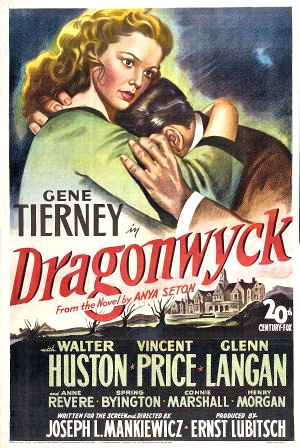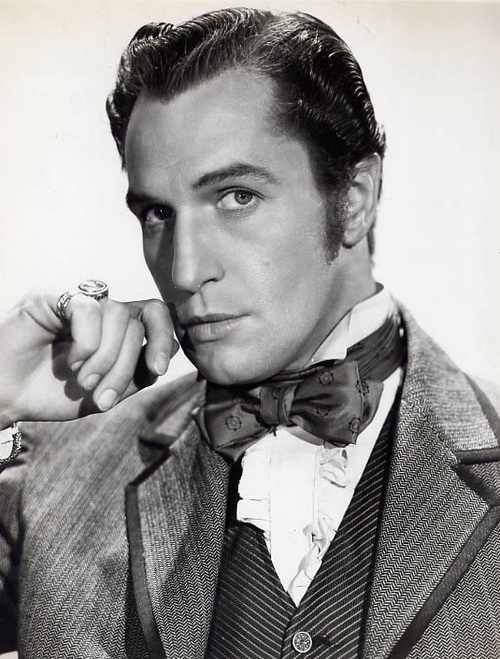Matt and I recently watched Dragonwyck (1946), one of the harder-to-track-down Vincent Price films. (We had to buy it in a “FOX Classic Horror” movie bundle with a couple of other ones). It’s also vastly different from pretty much any other Price film I’ve watched — it’s gothic romance, with all the trappings of haunted houses, brooding heroes, doomed families, and sense of being displaced in time.
Miranda Wells (Gene Tierney) is the daughter of a farmer in Greenwich, Connecticut in 1844. She’s a dreamy-headed girl who her parents think unmarriageable. Then a letter arrives from a distant sorta-relative named Nicholas Van Ryn (Vincent Price) — the patroon of Dragonwyck, a manor on the Hudson. She’s invited to Dragonwyck to be a governess to his daughter. Over some objection from her parents (who are about as unlikeable as can be), Miranda jumps at the chance to have anything to do with castles and lords.
Of course, everything unravels from there. The manor is haunted, naturally — by the ghost of the wife of the first patroon, who felt trapped and miserable there. Her haunting is a mellow sort — ghostly harpsichord playing that only those with Van Ryn blood can hear. The servants fear this, but the Van Ryns mostly disdain it.
Also there are those creeeeeeepy vibes Nicholas is sending Miranda’s way, making a point of saying they’re not really cousins (Miranda’s mother and Nicholas have the same grandfather; you do the math), and also some posh variety of “hey there, beautiful” (“the breeze must feel wonderful indeed with a face as beautiful as yours against it,” which sounds only marginally less ridiculous in Price’s mouth). He also comes to her rescue when she finds herself embroiled in a social mess at a ball he hosts.
Of course all of this is with his wife Johanna (Vivienne Osborne) standing right there.
Then the stuff with the tenant farmers starts up — they refuse to pay their rents, requesting the right to buy their land. After all, it is 1844 and they are living in the United States. This starts to bring out the crazy/evil in Nicholas; now he becomes obsessed with the fact that he doesn’t have a male heir and what will become of Dragonwyck, ohnoes. It doesn’t help that at this point Miranda strikes up a friendship with a local doctor and anti-renter, Jeff Turner (Glenn Lagan).
Given all this, and the genre, is it any surprise than Van Ryn decides to off his wife?
…is that a spoiler? The movie is 70 years old, in addition to this being a common gothic trope.
On the same night that that Johanna is dispatched (by poison: oleander), Nicholas, being sketchy as fuck in the delightful way only Vincent Price can be, commences the serious wooing of Miranda.
Next thing we know Miranda is going back to her family and acting very weird and skittish. When Nicholas shows up again, we figure out why–he’s going to ask her father for permission to marry. Reluctantly, he gives it.
Of course, this solves nothing. Nicholas is already becoming dictatorial by the time Miranda announces she’s pregnant. The baby is a boy, hooray! (And ooh boy, the weirdly detached way that 1940s movies depict pregnancy…) But he’s sickly, and dies right after being baptized.
This is all more of a pretext for Nicholas to descend further into madness, drug addiction, and yet more attempted poisoning. Miranda is only able to escape with the help of Dr. Turner, who arrives at a critical moment with a gun and a mob of angry farmers.
The final climactic scene of the movie is Nicholas being shot to death — right atop the seat where he used to take the feudal tithes at the annual kermis. Oh, while wearing a fabulous dressing gown. Because Vincent Price, of course. His dying words? “That’s right. Take off your hats in the presence of the patroon.”
As symbolic as this is, apparently the book ends with a steamboat chase scene, and I am kind of sad that wasn’t replicated here. I blame wartime austerity. (While the movie came out post-WWII, it was clearly made during it — the print we had has a “buy war bonds!” message on the opening credits scroll).
So that’s the plot synopsis. But what did I think?
It actually reminded me a lot of Crimson Peak — more than just being a gothic. The whole “female character prone to flights of fancy falls in love with a brooding gothic hero in a terrifying manor and is eventually ‘rescued’ by a down-to-earth doctor” brought a lot of the same feelings up.
(Which may have led to me saying, “I guess Vincent Price was the Tom Hiddleston of his day.” And like Hiddles in Crimson Peak, a 35-year-old Vincent Price in Victorian clothing is very fine to look at).
I actually find the historical background really, really interesting for this, for all that the movie barely touches on it. (The book, by Anya Seton, may do more — the movie felt like it was rushing through the Cliff Notes version). It’s set in 1844 in upstate NY*, which will twig any Rasputina fan’s sensibilities, if you’ve heard the song “Calico Indians,” about the anti-rent wars of the 1840s.
* (upstate NY by the most common meaning, which is “New York that is not New York City” — in particular the Catskills and the capital district. I admit, I object to this title, too; I was born in Plattsburgh, NY, which is basically southern Canada. But whatcha gonna do?)
Really the whole system of patroonships that led to the anti-rent wars is super interesting. The Dutch, arriving in the 17th century, set up what were basically feudal landholdings for people who pledged to settle a certain number of colonists to the Dutch West India Company. These became the “patroons,” from the Dutch word for “patron.”
While feudal landholdings were still a done thing in the 17th century (how else would Charles II have appeased his many mistresses?), they were not really present in any place and time in U.S. history… except the patroonships. These unlikely feudal holdings persisted until the family lines literally died off in the 19th century. (When the English took over from the Dutch, they just converted them to manors legally, but left them otherwise untouched).
“The Last Patroon” was Stephen Van Rensselaer, patroon of the Manor of Rensselaerswyck (shades of Dragonwyck, hm?) which gave us most of Albany and Rensselaer counties — also the dude what founded RPI.** His heirs, trying to collect the rent from the tenant farmers after his death in 1839, is what sparked the anti-rent wars.***
** If you’re familiar with New York’s capital district, you’ll also recall there’s a bridge near Troy called Patroon Island Bridge)
*** I’m not even touching on some of the wackiness of the anti-rent wars that the Rasputina song mentions, which Wikipedia summarizes as “Riders disguised as Indians and wearing calico gowns ranged through the countryside, terrorizing the agents of the landlords.”
And it’s in this fascinating Dutch diaspora, frozen in time, that Dragonwyck is set. (Another thing that reminds me of Crimson Peak — or is it gothic in general? — is that sense of being displaced in time). It’s embodied in how the ladies at the ball talk — speaking of the Hudson as if it’s the only river; assuming her name is “Van Wells.” We see it, too, in the kermis — a sort of festival that has its roots in Dutch culture — that takes up a good chunk of the story, and is where Miranda meets Jeff Turner.
Random “actors in this film who were way better known later in their careers” notes: At one point in the movie I was like, “I swear that voice is Harry Morgan’s!” (on Klaas Bleecker, one of the anti-renters). Indeed, Harry Morgan (who you probably know as Colonel Potter from M*A*S*H) is in this movie as “Henry Morgan.” Jessica Tandy also appears as Miranda’s maid Peggy O’Malley, complete with an awful “Oirish” accent.
All in all, it’s an engaging picture. If I have any complaints, it’s that I wished for more character development than we saw over the course of the story. Price is awesome as Van Ryn, of course, but in comparison all the other characters seem a bit wooden. I also just wanted MORE to the story — as I said, it felt like an abridged summary of the book. I think I may have to acquire a copy of Seton’s novel.
If you’re a Price fan, or you have an interest in the gothic genre, or weird U.S. history, you should definitely track down a copy of this unique American gothic.

